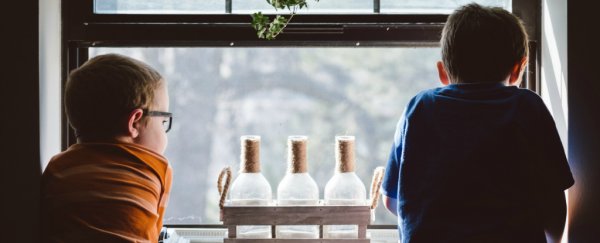Getting children to play outside will benefit their eyesight and reduce their risk of becoming shortsighted, experts say.
Shortsightedness, or myopia, is becoming increasingly common the world over. By 2050, nearly 4.8 billion people will be affected by this visual disorder, which is about 2.8 billion more people than in 2010.
In China, where over 90 percent of young people are shortsighted, the problem is considered an epidemic.
But while those who wear glasses commonly blame their genes, genetics alone cannot explain this rapidly developing problem.
Instead, experts say we've been underestimating how our eyesight is affected by the environment, and the outdoors in particular.
Today, there is a growing body of research that suggests outdoor play time can lower a child's risk of developing myopia.
Not only does being outdoors force you to look further into the distance, exposure to outdoor lighting is also thought to be vital, since it appears to slow the axial growth of the eye. Excessive growth is what contributes to myopia.
One study found that even when a child has two nearsighted parents, if they don't spend enough time outdoors, the genetic threat of myopia increases to about 60 percent.
In light of these developments, experts now think that the environment has a greater role to play in myopia than genetics.
A recent study on twins adds even more weight to that idea. It suggests that there are several environmental factors that can influence the development of myopia.
"There is not much you can do about when your child is born … but periods indoors doing indoor activities does increase your risk of myopia," co-author Katie Williams, who studies disorders of the eye at King's College London, told The Guardian.
"A healthy balance of time outdoors and a balance during early education is important."
The research followed 1,991 twins, born between 1994 and 1996 in the UK, using data from the twins early development study.
For the first sixteen years of life, the researchers analysed each child's development, behaviour and education through questionnaires and tests, as well as collecting eye tests.
Interestingly, the study pinpointed four major environmental factors that are linked to myopia, and some of them were quite unexpected.
For instance, the study found children born by fertility treatment were 25-30 percent less likely to develop myopia by their mid-teens.
"This could, in part, be related to the fact that infants born following fertility treatment tend to have a lower birth weight and shorter gestation and have, in some but not all studies, developmental delay and reduced cognitive scores," the authors write.
The study also found that those born during the summer were twice as likely to develop myopia - most likely because they start going to school younger than many of their peers.
Plus, for every higher level of education the mother had, the odds of the teenager having the condition rose by 33 percent. This could have something to do with the link between intelligence and myopia, although social factors like class and wealth probably also play a role.
And then, of course, there's technology. In the twin study, the hours spent playing computer games in early adolescence increased the odds of becoming myopic, too.
Although, this isn't simply because screen time is bad for your eyes (and it most certainly is). It's also a reflection of how little time we are spending outdoors - a relatively modern phenomenon that has been found to harm eye development.
"The increased [device screen time] resulting from gaming, social media, and digital entertainment has led to a rise in sedentary behaviour, poor diet and a lack of outdoor activity," the authors suggest.
The researchers reiterate, however, that these environmental factors are only correlated with myopia. And, as such, they do not necessarily cause shortsightedness.
But there's another part of the study that is perhaps even more limiting. The research was conducted on children born in the 90s, before the age of smartphones and other hand held devices.
Nowadays, with our eyes glued to the screen no matter where we are - even if it's outdoors - the problem is likely even worse.
"The rapid adoption of smart devices in children adds a new dimension to how we define and quantify near-work activity," the authors conclude.
"The role of smart devices, quantified as device screen time must also be investigated."
This study has been published in the British Journal of Ophthalmology.
